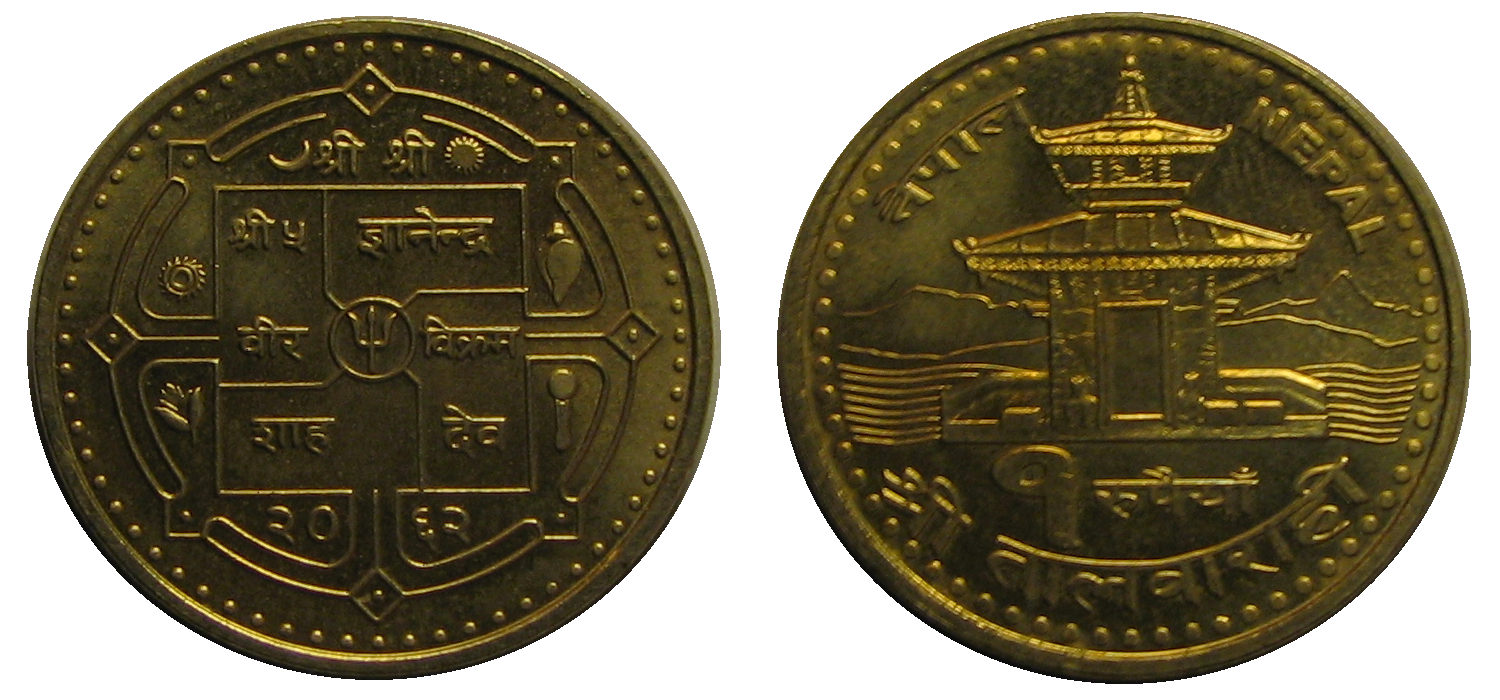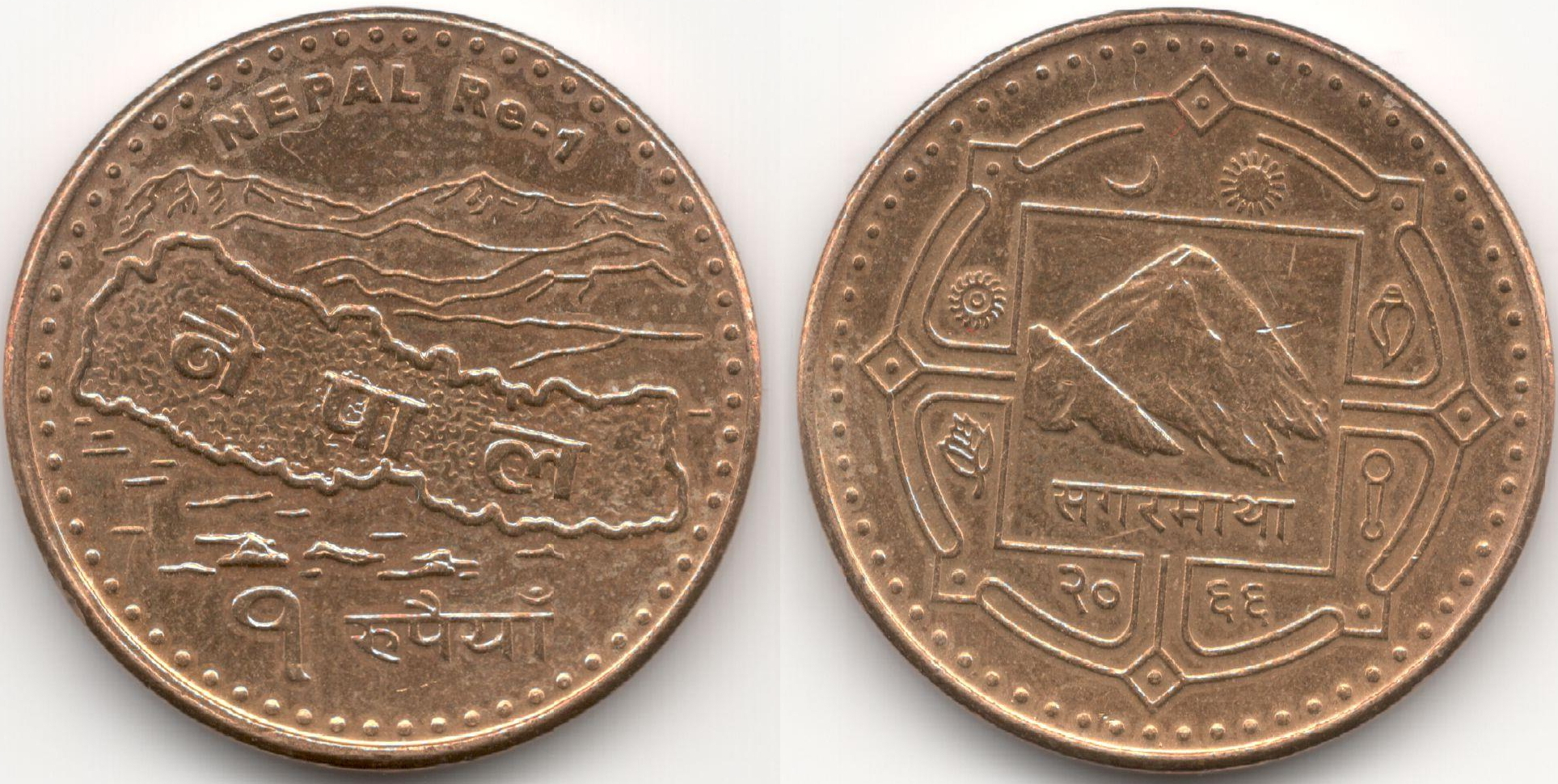Nepalese rupee on:
[Wikipedia]
[Google]
[Amazon]
The Nepalese rupee ( ne, रुपैयाँ;
 During King
During King

 In October 2007, a 500-rupee note was issued on which the king's portrait was replaced by
In October 2007, a 500-rupee note was issued on which the king's portrait was replaced by
symbol
A symbol is a mark, sign, or word that indicates, signifies, or is understood as representing an idea, object, or relationship. Symbols allow people to go beyond what is known or seen by creating linkages between otherwise very different conc ...
: रु; code
In communications and information processing, code is a system of rules to convert information—such as a letter, word, sound, image, or gesture—into another form, sometimes shortened or secret, for communication through a communication ...
: NPR) is the official currency
A currency, "in circulation", from la, currens, -entis, literally meaning "running" or "traversing" is a standardization of money in any form, in use or circulation as a medium of exchange, for example banknotes and coins.
A more general def ...
of the Federal Democratic Republic of Nepal
Nepal (; ne, नेपाल ), formerly the Federal Democratic Republic of Nepal ( ne,
सङ्घीय लोकतान्त्रिक गणतन्त्र नेपाल ), is a landlocked country in South Asia. It is mai ...
. The Nepalese rupee is subdivided into 100 ''paisa
Paisa (also transliterated as ''pice'', ''pesa'', ''poysha'', ''poisha'' and ''baisa'') is a monetary unit in several countries. The word is also a generalised idiom for money and wealth. In India, Nepal, and Pakistan, the ''Paisa'' currently equa ...
''. The issuance of the currency is controlled by the Nepal Rastra Bank
The Nepal Rastra Bank (NRB) ( ne, नेपाल राष्ट्र बैंक) was established April 26, 1956 A.D. ( Nepali Date: Baisakh 14, 2013 B.S.) under the Nepal Rastra Bank Act, 1955, to discharge the central banking responsibili ...
, the central bank of Nepal. The Nepalese rupee was introduced in 1932 when it replaced the Nepalese mohar
The mohar was the currency of the Kingdom of Nepal from the second half of the 17th century until 1932. Silver and gold mohars were issued, each subdivided into 128 ''dams''. Copper dams were also issued, together with copper ''paisa'' worth 4 c ...
at the rate 2:1.
The Nepalese rupee (रु) has been pegged to the Indian rupee
The Indian rupee ( symbol: ₹; code: INR) is the official currency in the republic of India. The rupee is subdivided into 100 ''paise'' (singular: ''paisa''), though as of 2022, coins of denomination of 1 rupee are the lowest value in use wh ...
(₹) at the rate रु1.60 = ₹1 since 1994; prior to this, it had been pegged at the rate रु1.45 = ₹1.
History
The rupee was introduced in 1932, replacing the silvermohar
The Mohur is a gold coin that was formerly minted by several governments, including British India and some of the princely states which existed alongside it, the Mughal Empire, Kingdom of Nepal, and Persia (chiefly Afghanistan). It was usually ...
at a rate of 2 mohar = 1 rupee. At first, the rupee was called the ''Mohru'' in Nepali.
The "Bullet paisa"
In 1955, 4 Paisa coins were minted, made from rifle cartridge cases fromWorld War II
World War II or the Second World War, often abbreviated as WWII or WW2, was a world war that lasted from 1939 to 1945. It involved the vast majority of the world's countries—including all of the great powers—forming two opposin ...
that were used by the Gurkha
The Gurkhas or Gorkhas (), with endonym Gorkhali ), are soldiers native to the Indian Subcontinent, chiefly residing within Nepal and some parts of Northeast India.
The Gurkha units are composed of Nepalis and Indian Gorkhas and are recruit ...
soldiers who fought against the Imperial Japanese in the Pacific. The coins were produced by removing the primer from the cases and the cases were then converted into the 4 Paisa coins to commemorate their courage and victory during the war.
Due to the small number of cases found, these coins were minted for one year only.
They are known as the "Nepal Bullet Paisa".
1972–2001
 During King
During King Birendra
Birendra Bir Bikram Shah Dev ( ne, श्री ५ महाराजाधिराज वीरेन्द्र वीर विक्रम शाह देव ) (28 December 1945 – 1 June 2001) was the tenth Shah Ruler and the King of N ...
’s rule, one can also distinguish between two major series of banknotes. The first series features the king wearing the military uniform while on the notes of the second series the king is wearing the traditional Nepalese crown adorned with feathers of the bird of paradise. During this period regular banknotes of 2 and 20 rupees and special banknotes of 25 and 250 rupees were issued for the first time. The legends found on the last issues of Gyanendra revert to Nepal ''sarkar'' ("Nepalese government"), thus omitting the reference to the king.
2007–2012

 In October 2007, a 500-rupee note was issued on which the king's portrait was replaced by
In October 2007, a 500-rupee note was issued on which the king's portrait was replaced by Mount Everest
Mount Everest (; Tibetan: ''Chomolungma'' ; ) is Earth's highest mountain above sea level, located in the Mahalangur Himal sub-range of the Himalayas. The China–Nepal border runs across its summit point. Its elevation (snow heig ...
. This reflects the historic change from a kingdom to a republic which took place in May 2008 in Nepal. Further notes of 5, 10, 20, 50, 100 and 1000 rupees with Mount Everest and without reference to the king in their legends followed in 2008. The first issues of the 500- and 1000-rupee notes were printed on paper which still had the king's crowned portrait as a watermark in the "window" on the right part of the face of the notes. It was decided to print a red Rhododendron flower (Nepal's national flower) on top of the watermark. Notes of these denominations which were issued in 2009 and thereafter are printed on paper which has a Rhododendron flower as watermark instead of the royal portrait and were therefore released without the additional overprint in red.
Banknotes
On 17 September 1945, the government introducedbanknotes
A banknote—also called a bill (North American English), paper money, or simply a note—is a type of negotiable instrument, negotiable promissory note, made by a bank or other licensed authority, payable to the bearer on demand.
Banknotes w ...
for 5, 10 and 100 rupees, with the name mohru used in Nepalese. There are also 250-rupee notes commemorating the Silver Jubilee of Birendra Bir Bikram Shah in 1997. Since 2007, Nepalese rupee banknotes have been produced by Perum Peruri
The Money-printing Public Corporation of the Republic of Indonesia ( id, Perusahaan Umum Percetakan Uang Republik Indonesia, shortened as Peruri) is the Indonesian state-owned banknote/ security printers and mint, established on 15 September 1971 ...
, the mint company of Indonesia
Indonesia, officially the Republic of Indonesia, is a country in Southeast Asia and Oceania between the Indian and Pacific oceans. It consists of over 17,000 islands, including Sumatra, Java, Sulawesi, and parts of Borneo and New Guine ...
.
In 2012, Nepal Rastra Bank issued a revised banknote series that is similar to the 2007 series, but now include inscriptions in English and the year of issue on the back.
Exchange rates
Between 1857 and 1930, the Nepalese rupee (two half-rupees or mohars) was fixed at 1.28 per Indian rupee. After this period, its value fluctuated against the Indian rupee, falling to रु1.60 = ₹1 in 1939, rising to रु0.60 = ₹1 during theSecond World War
World War II or the Second World War, often abbreviated as WWII or WW2, was a world war that lasted from 1939 to 1945. It involved the vast majority of the world's countries—including all of the great powers—forming two opposin ...
and falling again afterwards. In 1952, the government of Nepal officially pegged the Nepalese rupee at रु1.28 = ₹1, although the market rate remained at रु1.60 = ₹1.
Between 1955 and 1957, there was a series of soft peg revaluations that started at रु1.755 = ₹1 and appreciated to रु1.305 = ₹1 by 1957. In 1958, the government applied a new exchange rate of रु1.505 = ₹1 for the purchase of plane tickets only. A hard peg of रु1.60 = ₹1 was instituted in 1960, which was revalued to रु1.0155 = ₹1 when the Indian rupee was sharply devalued on 6 June 1966. The Indian rupee ceased to be legal tender in Nepal in 1966.
From 1967 to 1975, the government pegged the Nepalese rupee against the Indian rupee, the US dollar and gold, starting at रु1.35 = ₹1, रु10.125 = US$1 and रु1 = 0.08777g gold. By the time the gold peg was removed in 1978, the exchange rate was रु1.39075 = ₹1, रु12.50 = $1 and रु1 = 0.0808408g gold.
In 1983, the Nepali rupee's anchor was changed to a trade-weighted basket of currencies, which in practice amounted to a hard peg against the Indian rupee. This remained until 1993, when the peg was officially set at रु1.60 = ₹1.
See also
*Crore
A crore (; abbreviated cr) denotes ten million (10,000,000 or 107 in scientific notation) and is equal to 100 lakh in the Indian numbering system. It is written as 1,00,00,000 with the local 2,2,3 style of digit group separators (one lakh is e ...
* Economy of Nepal
The economy of Nepal is developing category and largely dependent on agriculture and remittances. An isolated, agrarian society until the mid-20th century, Nepal entered the modern era in 1951 without schools, hospitals, roads, telecommunicati ...
* Nepalese coins
The earliest coin minted in today's territory of Nepal was in Shakya Mahajanapada, along the India–Nepal border at around 500 BCE. Shakya coins were an example of a coin invented in the Indian subcontinent which continued to be used in Nep ...
References
Sources
* * * Agrawal (Giriya), Shyam and Gyawali, Kamal Prasad: Notes and Coins of Nepal. Nepal Rastra Bank Golden Jubilee Year 2005–06, Kathmandu, 2006. * Bertsch, Wolfgang: "The Legends on the Banknotes of Nepal", ''International Banknote Society (IBNS) Journal'', vol. 48, no. 3, 2009, p. 39–44. * Jha, Hari Jaya: An Overview of Nepalese Paper Money. Manjeeta Jha, Lalitpur (Patan), B.S. 2058 (= A.D. 2001). * Lorenzoli, Giovanni: "Nepali artistic buildings as seen on Nepali notes". Journal of the International Banknote Society, vol. 43, no. 3 (2004), p. 6–14. * Shrestha, Ramesh: Nepalese Coins & Bank Notes (1911 to 1955). Kazi Mudhusudan Raj Bhandary, Kathmandu, 2007. * Wittmann, Hans: Die Banknoten des Königreichs Nepal. Unpublished, Wiesbaden, 2002.Further reading
* {{Portal bar, Asia, Money, Nepal, Numismatics 1932 establishments in Nepal Currencies introduced in 1932 Currencies of Nepal Rupee, Nepalese Fixed exchange rate